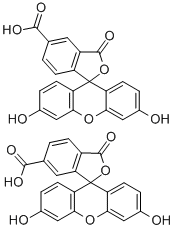5-Carboxyfluorescein
Synonym(s):5-Carboxyfluorescein;5-FAM
- CAS NO.:76823-03-5
- Empirical Formula: C21H12O7
- Molecular Weight: 376.32
- MDL number: MFCD00036874
- EINECS: 691-482-7
- SAFETY DATA SHEET (SDS)
- Update Date: 2024-11-19 23:02:33

What is 5-Carboxyfluorescein?
Description
5-Carboxyfluorescein is a single isomer derivative of 5(6)-carboxyfluorescein that can be used to fluorescently label biomolecules through the interaction of carboxylic acid with primary amines. It demonstrates excitation/emission maxima of 492 and 518 nm, respectively.
Chemical properties
Orange Solid
The Uses of 5-Carboxyfluorescein
5-Carboxyfluorescein(5-FAM) contains a carboxylic acid that can be used to react with primary amines via carbodiimide activation of the carboxylic acid. It is a useful reagent for the preparation of hydrolytically stable fluorescent conjugates and is a useful starting material for the synthesis of other fluorescein-derives reagent. It has been principally used to develop a variety of green fluorescent reagents and small fluorescent molecules due to its relatively high absorbance characteristics, excellent fluorescence quantum yield, and good water solubility. The probe has also found application in studies of liposome-cell, cell-cell, and liposome-liposome interactions and in related studies on lipid bilayer structures.
What are the applications of Application
5-Carboxyfluorescein is a highly soluble dye which is utilized as a pH indicator
Definition
ChEBI: 5-carboxyfluorescein is a monocarboxylic acid. It has a role as a fluorochrome. It is functionally related to a fluorescein (lactone form).
Biochem/physiol Actions
5-Carboxyfluorescein is used for the staining of cells to differentiate between live and dead cells. It helps in monitoring the integrity and intactness of the cell membrane. It is also used for the measurement of intracellular pH. 5-Carboxyfluorescein diacetate is a non-fluorescent molecule which is cleaved by intracellular esterases, thereby giving a green fluorescent product 5-carboxyfluorescein. In viable cells, the fluorescent molecule is impermeable to the cellular membrane.
Synthesis
5-Carboxyfluorescein is a mixture of 5- and 6-isomers prepared by the reaction of benzotricarboxylic anhydride with resorcinol and zinc chloride.
Reaction: 1,2,4-Benzenetricarboxylic anhydride (also called 4-carboxyphthalic anhydride, 25.0 g, 0.13 mol) was added to a solution of 1,3-dihydroxybenzene (also called resorcinol, 28.6 g, 0.26 mol) in methane sulfonic acid (1M). An air condenser was attached to the flask and the reaction was heated at 85°C in an open vessel for 24 h. After cooling to room temperature, the reaction mixture was poured into 7 volumes of ice/water. An orange-yellow precipitate formed; this was collected by filtration and dried in an oven at 200°C. This residue was recrystallized two times from methanol/hexane to give 1.0 g of 6-carboxyfluorescein methanesulfonic acid adduct 2b. The mother liquors from this procedure were collected, the solvent was removed in vacuo, and the residues were recrystallized two times from ethanol/hexanes to give 3.2 g of 5-carboxyfluorescein methanesulfonic acid adduct 2a. 
The methane sulfonic esters 2 are easily converted to the 5- and 6-carboxyfluoresceins 1 by treatment with sodium hydroxide solution then neutralizing with aqueous HCl.
Properties of 5-Carboxyfluorescein
| Melting point: | 368-372°C |
| Boiling point: | 725.2±60.0 °C(Predicted) |
| Density | 1.73±0.1 g/cm3(Predicted) |
| storage temp. | Keep in dark place,Sealed in dry,2-8°C |
| solubility | DMF: soluble |
| form | Solid |
| pka | 3.3, 4.6, 6.4, 7.0(at 25℃) |
| color | Yellow to orange |
| PH Range | Weak green ' uorescence (6.0) to strong green ' uourescence (7.2) |
| λmax | 492nm |
| BRN | 57037 |
| Major Application | Fluorescent probe, diagnosis of cancer, leukemia, colorectal cancer, polynucleotide, bacteria, pathogens, nucleic acid, hepatitis A virus, dengue virus, herpes simplex virus, gene, HIV type, cardiovascular risk factor |
| Biological Applications | Authenticating canned products; detecting/measuring citrate; as a substrate for measuring phospholipase activity; use in ophthalmology |
| CAS DataBase Reference | 76823-03-5(CAS DataBase Reference) |
Safety information for 5-Carboxyfluorescein
| Signal word | Warning |
| Pictogram(s) |
 Exclamation Mark Irritant GHS07 |
| GHS Hazard Statements |
H315:Skin corrosion/irritation H319:Serious eye damage/eye irritation |
| Precautionary Statement Codes |
P264:Wash hands thoroughly after handling. P264:Wash skin thouroughly after handling. P280:Wear protective gloves/protective clothing/eye protection/face protection. P305+P351+P338:IF IN EYES: Rinse cautiously with water for several minutes. Remove contact lenses, if present and easy to do. Continuerinsing. P337+P313:IF eye irritation persists: Get medical advice/attention. |
Computed Descriptors for 5-Carboxyfluorescein
| InChIKey | NJYVEMPWNAYQQN-UHFFFAOYSA-N |
New Products
(S)-3-Aminobutanenitrile hydrochloride 4-Methylphenylacetic acid N-Boc-D-alaninol N-BOC-D/L-ALANINOL Tert-butyl bis(2-chloroethyl)carbamate 3-Morpholino-1-(4-nitrophenyl)-5,6-dihydropyridin- 2(1H)-one Furan-2,5-Dicarboxylic Acid Tropic acid 1-Bromo-3,5-Di-Tert-Butylbenzene S-2-CHLORO PROPIONIC ACID ETHYL ISOCYANOACETATE 2-Bromo-1,3-Bis(Dimethylamino)Trimethinium Hexafluorophosphate 4-IODO BENZOIC ACID 3-NITRO-2-METHYL ANILINE 1-(2,4-DICHLOROPHENYL) ETHANAMINE (2-Hydroxyphenyl)acetonitrile 4-Bromopyrazole 2-(Cyanocyclohexyl)acetic acid 4-methoxy-3,5-dinitropyridine 1-(4-(aminomethyl)benzyl)urea hydrochloride 2-aminopropyl benzoate hydrochloride diethyl 2-(2-((tertbutoxycarbonyl)amino) ethyl)malonate tert-butyl 4- (ureidomethyl)benzylcarbamate Ethyl-2-chloro((4-methoxyphenyl)hydrazono)acetateRelated products of tetrahydrofuran








You may like
-
 5-Carboxyfluorescein CAS 76823-03-5View Details
5-Carboxyfluorescein CAS 76823-03-5View Details
76823-03-5 -
 5-Carboxyfluorescein CAS 76823-03-5View Details
5-Carboxyfluorescein CAS 76823-03-5View Details
76823-03-5 -
 5-Carboxyfluorescein CAS 76823-03-5View Details
5-Carboxyfluorescein CAS 76823-03-5View Details
76823-03-5 -
 1975-50-4 98%View Details
1975-50-4 98%View Details
1975-50-4 -
 2-HYDROXY BENZYL ALCOHOL 98%View Details
2-HYDROXY BENZYL ALCOHOL 98%View Details
90-01-7 -
 2-Chloro-1,3-Bis(Dimethylamino)Trimethinium Hexafluorophosphate 221615-75-4 98%View Details
2-Chloro-1,3-Bis(Dimethylamino)Trimethinium Hexafluorophosphate 221615-75-4 98%View Details
221615-75-4 -
 14714-50-2 (2-Hydroxyphenyl)acetonitrile 98+View Details
14714-50-2 (2-Hydroxyphenyl)acetonitrile 98+View Details
14714-50-2 -
 118753-70-1 98+View Details
118753-70-1 98+View Details
118753-70-1